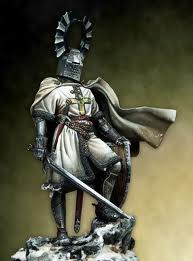Shield of Faith
 The Middle Ages molded men to serve their lords and their ladies as soldiers sheathed in armor. Knighthood wasn’t just a title or a symbolic honor as it is today. It was a position of trust forged within the complex relationships of medieval kingdoms and culture, requiring equal parts of metal and mettle. When placed in the crucible of combat, a knight covered his flesh in armor and picked up deadly weapons to keep himself safe. But the true strength of a knight was found deep within, in the chivalric code of conduct that defined his very being by developing virtues designed to keep others safe.
The Middle Ages molded men to serve their lords and their ladies as soldiers sheathed in armor. Knighthood wasn’t just a title or a symbolic honor as it is today. It was a position of trust forged within the complex relationships of medieval kingdoms and culture, requiring equal parts of metal and mettle. When placed in the crucible of combat, a knight covered his flesh in armor and picked up deadly weapons to keep himself safe. But the true strength of a knight was found deep within, in the chivalric code of conduct that defined his very being by developing virtues designed to keep others safe.
Where do we find men with such sure, exterior security and strong, interior principles today, when we need them perhaps more than ever before? The truth is, there is a knight within each of us, waiting to be formed and sent on a mission. Therefore, in the weeks ahead, Fathers for Good will be publishing a series of columns under the theme “Armor of Virtue.” They will combine what distinguished knights of old – a mixture of external metal and interior mettle – into tools that modern knights can use in their daily campaigns to protect their marriages and families. In addition to pulling from the armory of teachings found in Scripture and the Catechism of the Catholic Church, these columns also will draw practical tips from the Manual for Spiritual Warfare by Paul Thigpen.
The first instrument for our modern knight to mold is a shield forged in the virtue of faith. The Catechism teaches that faith begins with the grace to believe in God, in “all that he has said and revealed to us,” and in everything “that Holy Church proposes for our belief” (1814). Faith is the first of the theological virtues, which “have God for their origin, their motive, and their object – God known by faith, God hoped in and loved for his own sake” (1840). Faith calls for concrete actions: “[P]rofess it, confidently bear witness to it, and spread it” (1816).
It makes perfect sense then to emphasis faith as the primary ingredient in our first line of defense. Like a shield, urges Thigpen, faith “must be firmly grasped” and “held up as a barrier” between ourselves and the Enemy (58). Gripped with firm conviction, it reflects both “a knowledge of God” and “a confident trust in Him” (58). And when wielded well and without fear, it “renders powerless the doubts and accusations [the Devil] hurls at us” (58).
“In all circumstances,” reads the first-century letter from Paul to the Ephesians, “hold faith as a shield, to quench all [the] flaming arrows of the evil one” (6:16). Such an apostolic summons to spiritual combat readiness still rings with urgency this day, when the basic building blocks of a healthy society – marriage and family – are under attack by those who would redefine our identities as men and women.
The moment has indeed arrived in our society for faithful men, new knights armed with shields of faith and under the titles of providing husbands and protecting fathers, to rally together for the safety of all.
Next week: “Helmet of Hope.”
Originally published at Fathers for Good and is used with permission.

